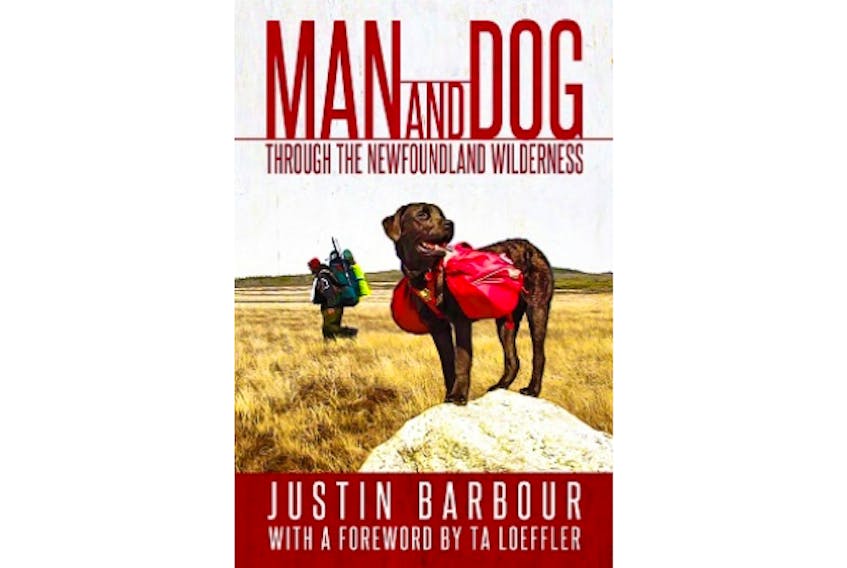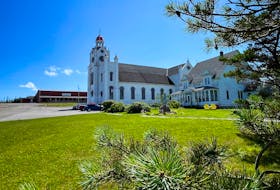These companion books tell the tales of two bold voyagers who set out together in April 2017 to cross 700 kilometres of Newfoundland’s interior, from Robinsons to Cape Broyle. Justin Barbour, long drawn to the Newfoundland and Labrador outdoors, and with an increasing tally of impressive wilderness feats, and Saku, descended from Cape Shore water dogs and named for NHL’s Saku Koivu, made the tremendously challenging trek all at their own speed and power, by raft, foot and paw.

Barbour built his first lean-to when still a kid. He’s steeped in the allure of the wild and has researched the lore transcribing historic and record-setting expeditions (Cormack, Hubbard, Howley). He meticulously planned this trip, including his choice to bring Saku, training the pup to swim and carry a pack.
“Man and Dog” is a step-by-step guide to their quest, starting with complete lists of navigation/communications apparatus, technology, clothing system (“camp sneakers to get out of wet boots”), camping gear system (“Gransfors Bruks small forest axe”), cooking gear, hunting/fishing gear and transportation (“Alpacka raft”). Saku’s account is both standalone and loyally complementary (and the illustrations are vivid and alive) with sidebar nuggets on, for example, Saku’s own outfitting.
Barbour’s narrative is structured as a day-to-day journal, organized chronologically and geographically. He gives intricately detailed descriptions of the weather, the terrain, the trials and tests, his mindset, and any wildlife they encounter. It’s engrossing, page-turning stuff: how he weighs packing a sled or traversing a frozen river, what goes right and what goes wrong. Especially as “wrong” can mean “getting hurt” or “going hungry” — or worse.
Some of the information is highly technical, such as how equipment is ranked for specific conditions and temperatures. But overall it’s generally accessible: “That (hip strain) was normal when carrying such an enormous weight (eighty-five pounds). Over time it hardens your body and you either don’t feel the pain anymore or you find a way to mentally block it out”; “On a trip like this, sleep is never solid. It’s more like a series of naps that add up to some amount of rest.”
He always has to measure the calories he’s consuming versus what he’s expending. He continually emphasizes the necessity of patience: “After three weeks of travel, I had come to realize that solo expeditions require much more effort and take much more time to get tasks done than I had expected.”

Even more, Barbour lays out an approach to more general life obstacles:
“I’ve realized that in life not everyone will agree with you or be on your side. The important thing is not to let it bother you, and stop looking for acceptance or permission from others. It takes too much time and will likely never happen, and the time is better spent doing what you need to reach your goal. When you do that, happiness follows.”
Or: “As I grow older I am beginning to notice that most challenges are head games. If you can put yourself in the right frame of mind, you will find that life gets easier.”
(Keeping your feet dry and warm applies, of course, always.)
Barbour also contends with the limitations of his budget, which for example dictated his choice of tent. But his ultimate goal is to share the freedom and beauty of what he finds in “…our community in the woods, with a population of one man and one dog…” (Although they do encounter the odd humans, like Newfoundland and Labrador Hydro workers flown into remote areas, who meet him with bemusement and generosity.)
The dynamics between Barbour and Saku ground the story. Saku is an alert, comforting presence. What could be a better adventure than someone and their dog heading off into the wild yonder, the outcome totally reliant on their resources and characters, in pursuit of “living with the rhythms of the earth”? It’s inspiring on so many levels. (And this is coming from someone who will, and I cannot emphasize this enough, never do anything like this.)
Ultimately, Barbour writes, this is what allows us to “feel like you truly are the animal you are supposed to be.”
“Man and Dog” includes some black-and-white and a small selection of colour photographs, an Index, and Fun Facts (“Gear broken and lost: too much”). Altogether there’s a stimulating wealth of knowledge gathered, earned and shared.
Joan Sullivan is editor of Newfoundland Quarterly magazine. She reviews both fiction and non-fiction for The Telegram.
RELATED:









